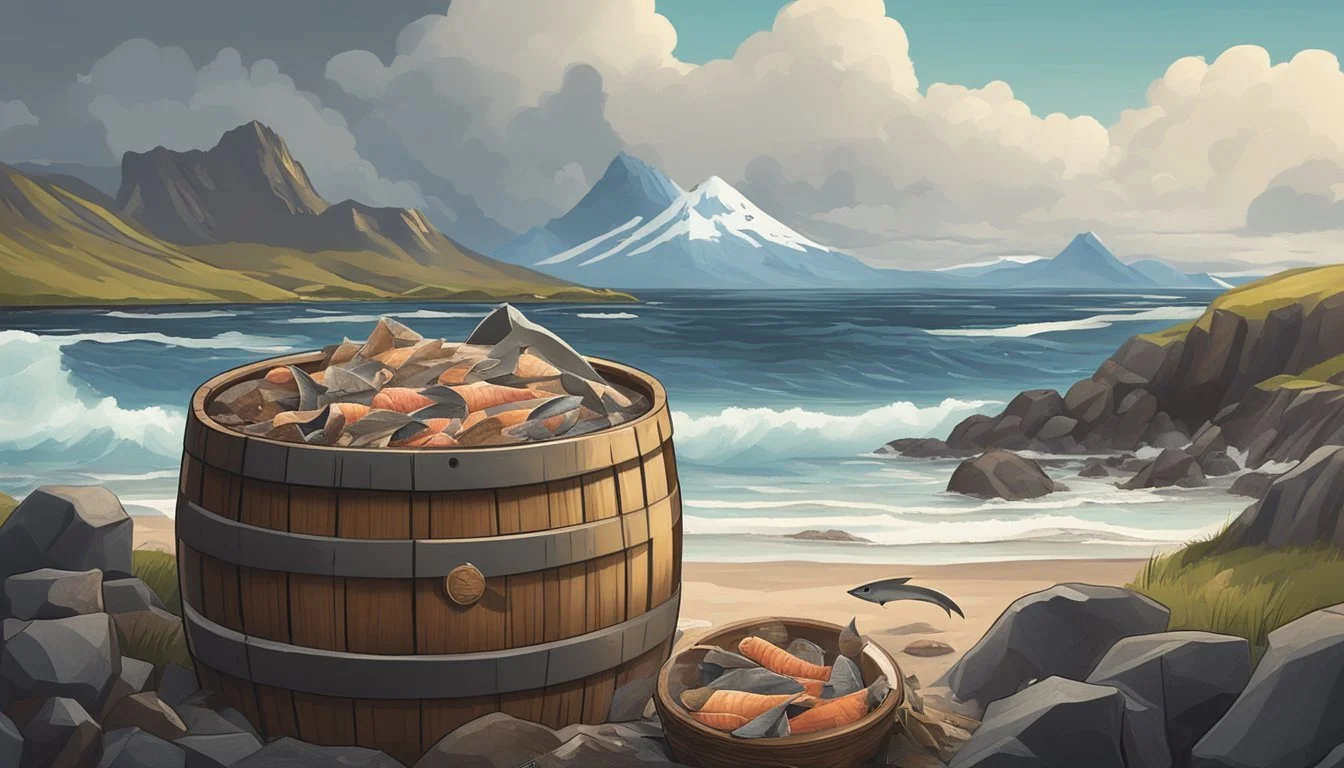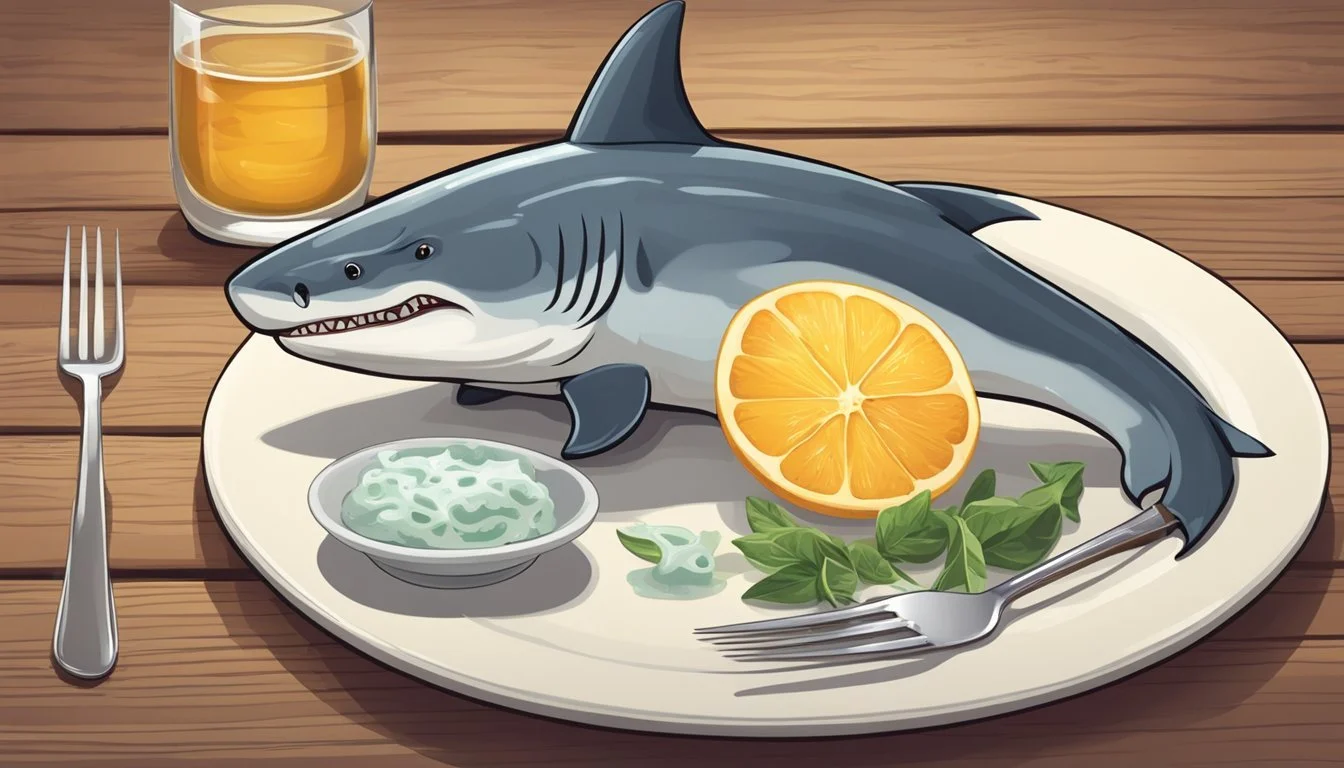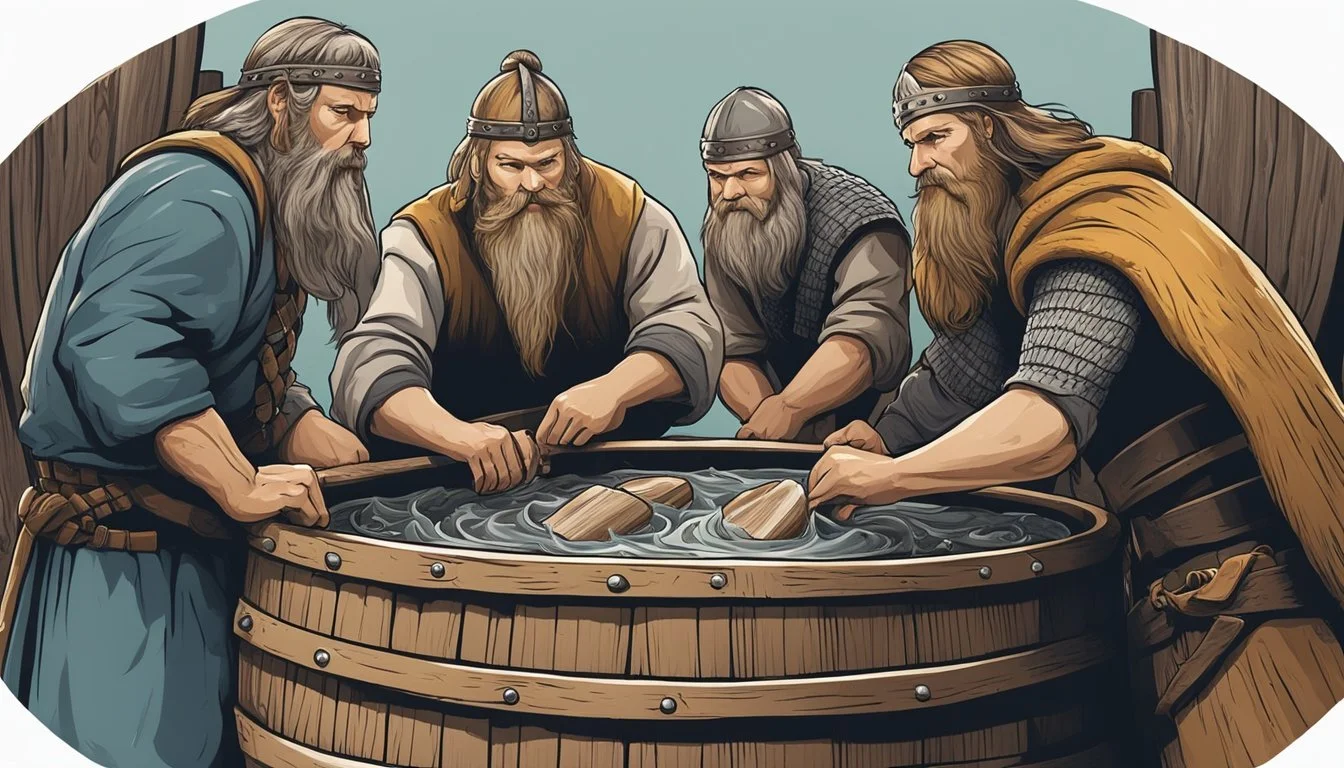Hákarl Unveiling Iceland's Traditional Fermented Shark Delicacy
Hákarl is a traditional Icelandic dish that encapsulates the daring and resilience of the country’s culinary history. Originating from a time when preservation of food was a matter of survival, Hákarl is made from the meat of the Greenland shark, a creature renowned for its longevity and often found in the cold waters of the North Atlantic. The Greenland shark's flesh is naturally toxic when fresh due to high levels of urea and trimethylamine oxide, a defense against the intense deep-sea pressure and cold. However, through a centuries-old fermentation process, the toxins are neutralized, rendering the meat edible.
The preparation of Hákarl involves a specialized fermentation process where the shark's meat is buried in gravelly sand for weeks, allowing it to ferment under pressure from stones placed atop. This period of fermentation is followed by a drying phase that lasts several months, during which the meat is hung in open structures where it's exposed to the cold, circulating air. The final product is characterized by its sharp, ammonia-rich odor and an acquired fishy taste that has been described as a cross between cheese and strong fish.
Enjoyed by Icelanders, especially during the winter festival of Þorrablót, Hákarl connects them to their Viking ancestors and serves as a symbol of national pride. The dish is often paired with a shot of Brennivín, Iceland's signature spirit, to complement its potent flavor profile. As the world becomes more curious about unique foods, Hákarl stands as a testament to Iceland’s ingenuity in food preservation, a pungent taste of the country’s rich gastronomic heritage.
Origins of Hákarl
The heritage of hákarl is deeply entwined with Iceland's past, reflecting a culinary innovation born from Viking survival tactics and evolving into a notable element of Icelandic cuisine.
Viking Traditions
Vikings are credited with the discovery of Iceland and the tradition of hákarl can be traced back to these seafaring Norse people. Survival in Iceland's harsh conditions necessitated inventive food preservation methods. The Vikings utilized the natural environment to ferment shark meat, a technique vital to their sustenance and deeply embedded in Iceland's history.
Method: They buried the shark underground, allowing it to ferment naturally.
Result: This process neutralized the naturally occurring toxins in the shark's flesh.
Development of Fermented Shark Cuisine
Over time, fermented shark, known as hákarl, transitioned from a mere sustenance practice to a unique facet of Icelandic cuisine. It stands as a culinary hallmark that reflects the country's history and tradition in every pungent bite.
Form: Eventually, the curing method evolved to include a drying phase, lasting several months.
Acceptance: Despite its strong odor and acquired taste, hákarl has gained respect and remains a celebrated traditional dish in Iceland today.
Understanding Hákarl
Hákarl, a traditional Icelandic dish, exemplifies the nation's culinary heritage through its unique preparation of fermented Greenland shark. Its distinct flavor and historical significance continue to captivate both the locals and the curious traveler.
What is Hákarl?
Hákarl is the Icelandic name for a dish made from fermented Greenland shark. The shark itself contains naturally occurring toxins when alive; thus, the fermentation process is essential to make the meat safe for consumption. It involves curing the shark's meat with a particular method that converts poisonous substances into non-toxic compounds. Once the shark is processed and fermented, it is hung to dry for several months, leading to a strong-smelling and sharp-tasting final product.
Culinary Significance
As a part of Iceland's gastronomical culture, hákarl is often considered a delicacy. It connects present-day Icelanders with their ancestral practices and Viking heritage. The dish is especially popular during the Icelandic midwinter festival known as Þorrablót. For some, hákarl is more than just food; it's a challenge and a testament to the robust Icelandic spirit.
The Greenland Shark
The Greenland shark, or Somniosus microcephalus, is central to the production of hákarl. It is a large, cold-water species that can live for hundreds of years and grow to considerable lengths. The meat of the Greenland shark is poisonous when fresh due to high concentrations of urea and trimethylamine oxide. Only through the process of fermentation does the meat become edible, as the harmful components are broken down.
Traditional Production Process
Hákarl is synonymous with a process widely considered challenging due to the extreme flavors it presents. This section unfolds the steps Icelandic tradition employs to transform a toxic shark into an edible delicacy.
Fermentation Techniques
The journey of producing hákarl begins with the Greenland shark, a species whose fresh meat is toxic due to high levels of urea and trimethylamine oxide. The fermentation process neutralizes these compounds. Initially, the shark is gutted and beheaded, and the meat is portioned. The traditional fermentation involves placing these meat chunks into a shallow grave, where they are covered with sand and gravel. The pressing weight aids in forcing out fluids that contain the harmful substances.
Burying and Curing
The meat remains buried for 6-12 weeks, depending on the season. During this time, a complex chemical process unfolds—enzymatic action facilitated by bacteria already present in the shark's flesh breaks down the toxic compounds. The combination of pressure, temperature, and natural bacteria is key in these curing stages which transform the hazardous meat into one safe for consumption.
Drying and Cutting
Post-fermentation, the shark is exhumed and cut into strips. These strips are then hung to dry for several months in a well-ventilated structure, often a drying shed. As it air-dries, a brown crust forms on the surface which is later removed. The drying process further develops the hákarl's distinct flavor and chewy texture. This method, often compared to producing Hangikjöt (smoked meat), results in a cured product that's both shelf-stable and imbued with a unique taste profile.
Taste and Consumption
The unique flavor profile and traditional serving methods of Hákarl make it a memorable experience for both locals and visitors. It is often accompanied by specific Icelandic beverages and sides to balance its strong taste.
Describing the Taste
Hákarl's taste is often described as an acquired one, characterized by a potent combination of ammonia-rich aromas and a pungent, fishy flavor. Its flesh is chewy and can have a texture akin to cheese with a slight resilience. First-timers may find the taste challenging, but it is a cherished tradition in Icelandic cuisine.
Common Accompaniments
When consuming Hákarl, it is traditionally paired with Brennivín, a clear, unsweetened schnapps that is considered Iceland's signature distilled beverage. This strong drink is thought to complement the shark's robust flavor. Additionally, rye bread (rúgbrauð), with its sweet, dense qualities, commonly accompanies the dish to balance the intense taste.
Serving Traditions
During the Þorrablót midwinter festival, Hákarl is served as part of a þorramatur platter, which includes an array of traditional Icelandic foods such as Svið, or singed sheep's head. The shark meat is typically presented in bite-sized cubes on toothpicks for ease of consumption. As part of tradition, it is encouraged to breathe out after swallowing to manage the strong aftertaste.
Cultural and Historical Relevance
Within the fabric of Icelandic culture, hákarl is more than a dish; it's a symbol of national identity and a direct link to the country's Viking ancestors. Its preparation method has been passed down through generations, holding significant historical importance.
Hákarl in Icelandic Festivals
Þorrablót is an Icelandic midwinter festival where hákarl plays a starring role. They celebrate this occasion by savoring traditional Icelandic foods, of which hákarl is a customary component. Every year, Icelanders gather in the heart of winter, honoring age-old customs and hákarl is present, stressing its enduring place in cultural festivities.
Role in Icelandic Identity
Regarded as a National Dish, hákarl represents the resilience and adaptability of the Icelandic people. Its consumption is a testament to historical significance, where ancestors creatively preserved their food in harsh climates. Today, this Traditional Icelandic Food not only connects Icelanders to their past but also distinguishes their gastronomy on an international stage, reinforcing their unique cultural identity.
Hákarl Today
Despite its notorious scent and flavor, hákarl holds a firm place in Icelandic culture, intertwining tradition with modern culinary experiences. Locals continue to cherish it as a cultural staple, while tourists often encounter it as a daring taste test. In Reykjavik and beyond, hákarl has found its way from Icelandic tradition to contemporary relevance.
From Niche to Mainstream
Once a survival food, hákarl has transcended its niche origins to become a symbol of Icelandic heritage. Even today, locals in Iceland, notably the older generation, consume hákarl as part of their diets, appreciating the dish for its historical significance. It represents a connection to the past and is a subject of national pride, even as tastes evolve and younger generations might be less inclined to include it in their everyday culinary choices.
Tourism and Culinary Adventures
Tourists to Iceland often embrace the challenge of trying hákarl, making it a noteworthy checkpoint on their culinary adventures. The dish is regularly featured on Reykjavik food tours, providing visitors with an authentic taste of Iceland's gastronomy. They approach the experience with a mix of trepidation and excitement, and for many, tasting hákarl becomes a highlight of their Icelandic journey - a moment of overcoming personal boundaries and engaging with local traditions.
Availability in Stores and Restaurants
Hákarl is readily available in grocery stores and certain restaurants throughout Iceland, ensuring that anyone can sample this iconic dish. In Reykjavik, its presence is felt strongly in specialty food markets where it's often sold in vacuum-sealed packages, making it accessible for both residents and visitors. Restaurants that focus on traditional Icelandic cuisine sometimes include hákarl on their menus, providing a well-rounded experience in a prepared culinary setting. Here's a simple breakdown of its availability:
Location: Grocery Stores
Availability: Packaged hákarl
Location: Specialty Markets
Availability: Fresh hákarl
Location: Restaurants
Availability: Menu item, especially in traditional Icelandic eateries
Health and Safety
When consuming hákarl, it's crucial to consider both its nutritional content and the necessary steps to ensure that the meat is free from toxins and safe to eat. This involves understanding the fermenting process that neutralizes harmful substances and recognizing proper consumption practices.
Nutritional Information
Hákarl is a rich source of protein, an essential macronutrient necessary for the building and repair of tissues in the body. It also contains varying amounts of fat, which is an important energy source and aids in the absorption of vitamins.
Nutritional content per 100g of hákarl:
Protein: Approximately 18g
Fat: Varies, but can be high in omega-3 fatty acids
Dealing with Toxins
The Greenland shark, from which hákarl is made, contains natural toxins in its flesh that can be harmful if consumed raw. The traditional Icelandic fermenting process is specifically designed to neutralize these toxins. By burying the shark and allowing it to ferment, then later hanging it to dry, the toxin content, such as trimethylamine oxide—which can turn into toxic tertiary amines—is significantly reduced, rendering the meat safe to eat.
Safe Consumption Practices
To ensure safety, the following practices must be strictly adhered to:
Preparation: Hákarl must be prepared using traditional methods of fermentation and drying to minimize toxin content.
Storage: It should be stored in a cool, dry place to prevent spoilage.
Serving: Consume hákarl in moderation due to its potency and intense flavor profile.
Consuming hákarl in accordance with Icelandic tradition is generally considered safe. However, individuals with specific health conditions or dietary restrictions should consult healthcare providers before trying this distinctive Icelandic delicacy.
Critical Perspectives
Hákarl has a potent reputation among food critics, celebrity chefs, and culinarians. The diverging opinions on this Icelandic delicacy ignite debates on taste, culinary traditions, and food exploration.
Famous Reactions and Quotes
Anthony Bourdain, a revered food connoisseur, famously described Hákarl as "the single worst, most disgusting and terrible tasting thing" he had ever eaten. Gordon Ramsay, known for his sharp palate, struggled to keep the fermented shark down. On the other hand, Andrew Zimmern, who hosts a show about bizarre foods, managed to eat it but implied it was certainly not to his taste. James May, from the motoring series Top Gear, also sampled Hákarl, reacting less dramatically but still with visible distaste.
Anthony Bourdain: "the single worst, most disgusting and terrible tasting thing"
Gordon Ramsay: visible struggle to consume Hákarl
Andrew Zimmern: managed to eat it, without showing a liking
James May: visible distaste for the fermented delicacy
Modern Criticism and Debates
The continued making and consumption of Hákarl is a subject of debate. Critics question whether its preparation, involving the burying and fermenting of shark meat, makes it a gastronomical adventure or a needless endurance of unpleasant flavors. Cuisine experts sometimes regard traditional foods such as Hákarl with respect for cultural heritage, challenging that it's an acquired taste worth preserving. Debates also extend to ethical considerations regarding the Greenland shark, from which Hákarl is made.
Culinary Heritage: Bold defense of traditional methods and tastes
Ethical Concerns: Discussion about the use and treatment of Greenland sharks
Conservation and Sustainability
In the discussion of Hákarl production, environmental impact and shark conservation efforts are paramount. Both socioeconomic factors and ecological considerations play vital roles in ensuring the practice is sustainable and minimally detrimental to the species and ecosystem.
Environmental Impact
The Greenland shark, a species often associated with Hákarl, is not only known for its unique meat but also for being one of the longest-living vertebrates. These sharks are partially blind and thrive in the frigid waters of the North Atlantic and Arctic Oceans. The production of Hákarl leverages Greenland sharks' naturally adapted biochemistry that allows the meat to ferment without rotting, which transforms it into the dish known today.
However, the process of Hákarl production involves careful conservation management to mitigate the environmental impact. It ensures that the practice does not lead to the overexploitation of Greenland sharks, which are a crucial part of the marine ecosystem. Each step, from catching the sharks to the fermentation process, is subject to strict regulations designed to minimize ecological disturbance and promote the sustainable use of marine resources.
Shark Conservation Efforts
Conservation efforts for the Greenland shark are essential due to their slow growth and reproduction rates. These sharks, which can live for hundreds of years, do not reach sexual maturity until around 150 years of age, making their population growth slow and any impacts from fishing potentially more severe.
As a part of sustainability practices, regulations may include quotas on the catch, protected areas where fishing is restricted, and research initiatives to better understand the species' behavior and population dynamics. These measures help maintain the population of Greenland sharks at a sustainable level and ensure that the tradition of Hákarl can continue without compromising the species' survival.
Through these endeavors, Iceland demonstrates a commitment not only to preserving its cultural heritage but also to the responsible stewardship of its natural resources, balancing tradition with ecological awareness.







